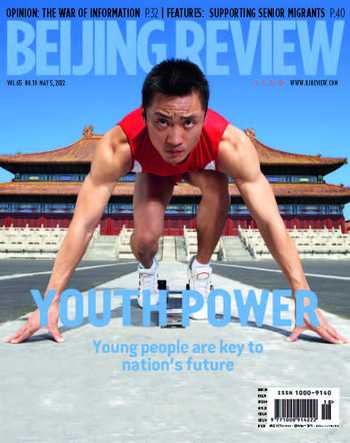THIS WEEK
THE WINTER OLYMPIC EXPERIENCE

The National Sliding Center for bobsled, luge and skeleton and the Winter Olympic Village in Beijing’s Yanqing District on April 26. Venues of the Olympic Winter Games Beijing 2022 and the Olympic Village opened to public on April 29. People can now visit the National Alpine Skiing Center and National Sliding Center in the capital’s northern suburb, treat themselves to an Olympic dish or two and try out the village’s accommodations.
Homecoming

China’s research icebreakerarrives in Shanghai on April 26, marking the end of the country’s 38th Antarctic expedition. Two icebreakers participated in the 174-day Antarctic expedition, with thearriving in Shanghai six days ago. The scientific venture involved a range of tasks,including the replenishment of materials and staff rotation at China’s Zhongshan and Great Wall stations in the region, as well as marine observations and oceanic ecosystem investigations.
Safety Standards
New Vaccine
The Ministry of Housing and Urban-Rural Development has unveiled a new set of standards to avoid major hidden dangers in the construction of urban housing projects. The standards aim to ensure workplace safety and prevent major accidents,Xinhua News Agency reported on April 26.
Hidden dangers in the housing sector include problems that may cause death, injury or major economic loss during the construction process, according to the ministry.
Enterprises and individuals undertaking unlicensed construction should be considered major risks.
In recent years, China’s work safety in the construction sector has been generally stable, with fewer major accidents reported, an official with the ministry said. However,the official warned that the total number of accidents still remains relatively high, and the risk of major accidents has not yet been eradicated.
The ministry called on relative departments to focus on the safety inspections of large projects and high-risk operations, to eliminate major hidden dangers and ensure construction site risks are controllable.A Chinese-made inactivated vaccine against the Omicron variant of the novel coronavirus was approved for clinical trials by the National Medical Products Administration on April 26.
The vaccine, developed by the China National Biotec Group affiliated with Sinopharm,has been under research since December 2021, the company said.
Preliminary tests, for safety and efficacy, showed that the vaccine can produce antibodies that are highly effective against various variants including Omicron, it said.
In the clinical trials, a randomized, double-blind and cohort study method will be adopted, studying people aged 18 and above who have received two or three doses of other COVID-19 vaccines.
Highway Network
The total length of China’s highway network has reached 5.28 million km, an official said on April 26.
Zhou Rongfeng, an official with the Ministry of Transport,underscored the importance of strengthening highway maintenance and management as highways are among the most widely used means of transportation, with the most extensive coverage and the largest number of passengers.
A total of 1.29 trillion yuan($196.7 billion) has been channeled into highway maintenance and addressing highway safety hazards in recent years, according to the ministry.
According to Zhou, the country will continue to increase its highway maintenance and management over the 14th Five-Year Plan (2021-25) period.
Efforts will be made to renovate old bridges and tunnels,accelerate the construction of battery charging and swapping stations, and improve electronic toll collection services, Zhou said.
Yellow River Protection
The State Council has announced it will support Ningxia Hui Autonomous Region in developing a pilot zone for the ecological protection and high-quality development of the Yellow River basin, Xinhua reported on April 26.
The statement urged efforts to take water into account when managing the city, land, people and production, while unswervingly following the path of green and low-carbon development.
Hard work is required to address environmental problems,conserve and control water, and protect and restore ecosystems,with solid progress made in Yellow River protection, according to the statement.
Last year, Chinese authorities issued a plan to improve the conservation and utilization of water resources in the Yellow River basin as part of the country’s efforts to advance ecological protection and the region’s highquality development.
By 2025, water consumption per 10,000 yuan ($1,570) of GDP in the Yellow River basin should be capped below 47 cubic meters,down 16 percent from the 2020 level, according to the plan.
Sewage Treatment
Sewage treatment in rural areas will be improved and the rural domestic sewage treatment rate will reach 40 percent in 2025,up from 28 percent in 2020,the Ministry of Ecology and Environment said on April 22.
Government organizations,market entities and villagers will be encouraged to join hands to achieve this goal, the ministry said.
Rural sewage treatment has faced the challenges of high costs, long investment return cycles and a lack of maintenance staff.
The move is part of China’s efforts to push forward rural revitalization.
Tourism Vouchers
The Yunnan Provincial Bureau of Culture and Tourism began handing out vouchers worth a total of 300 million yuan ($45.7 million) on April 25, with the aim of boosting tourism within the province.
The vouchers, consisting of 200 million yuan ($30.5 million)for the consumption of tourism products and services, and 100 million yuan ($15.2 million) for consumption at gas stations, will be handed out in several rounds throughout the year to residents of Yunnan and neighboring provinces.
A representative of the bureau said the move aims not only to stimulate cultural and tourism consumption, but also to lift market confidence.
Kindergarten Growth
The number of kindergartens in China reached 295,000 in 2021,up nearly 77 percent from a decade ago, according to the Ministry of Education on April 26.Of all the new kindergartens established in the period, around 60 percent are located in rural areas. By 2021, the country boasted 245,000 governmentfunded and privately-run non-profit kindergartens,representing 83 percent of all kindergartens nationwide.
The figures also showed that the gross preschool enrollment ratio rose to about 88 percent in 2021 from 62.3 percent in 2011.
The preschool education workforce in the country is also experiencing strong growth.According to the ministry,in 2021, China’s number of kindergarten principals and professional teachers reached over 3.5 million, 2 million more than in 2011.
Budding Bibliophiles

Parents and children immersed in reading at a bookstore on World Book Day in Xiamen, Fujian Province, on April 23.
Sufficient Supplies
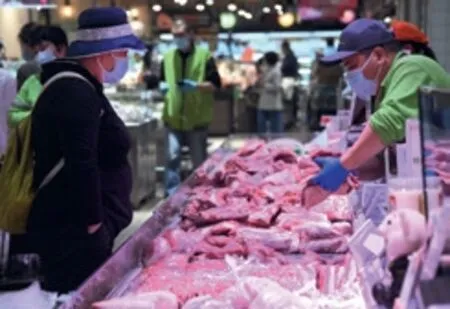
A shopper selects meat at a supermarket in Haidian District, Beijing,on April 26. Agricultural product wholesale markets, supermarkets and logistics companies in Beijing have taken measures to ensure the supply of daily necessities for residents following a recent COVID-19 resurgence in several of the city’s districts.
Consumption Boost
The General Office of the State Council on April 25 unveiled guidelines to further tap into the country’s consumption potential.As part of measures to tackle short-term bottlenecks, large and medium-sized cities will build warehouses in their suburban areas to ensure the supply of daily necessities in case of emergencies.
Financial institutions are required to provide more support to the real economy through policies such as lowering interest rates and cutting fees.
To boost consumption in the medium and long term, the country will develop products and services that cater to the needs of the elderly and infants,while encouraging innovations in cultural consumption.
Further efforts will tap into the potential of the vast rural areas, promoting the sales of automobiles and home appliances there.
In addition, restrictions on vehicle sales in urban areas are called to be phased out.
The government also plans to establish several duty-free shops within the cities and improve related policies to develop pro-consumption platforms.
Consumption is a primary engine for economic growth in China. In the first quarter of 2022,final consumption contributed 69.4 percent to GDP expansion,which came in at 4.8 percent year on year.
Canton Fair
The number of overseas purchasers registered for the justconcluded 131st Session of the China Import and Export Fair,also known as the Canton Fair,hit a record high of 536,000,coming from 228 countries and regions.
Running from April 15 to 24,this edition took place online due to COVID-19 restrictions.
The number of registered overseas buyers increased by 48 percent compared with the 129th session and 41.8 percent from the 130th session, according to Xu Bing, spokesperson for the fair.
Among them, 298,100 were from other Belt and Road Initiative participants, accounting for more than 55 percent of the total, while 150,800 came from members of the Regional Comprehensive Economic Partnership, constituting over 28 percent, Xu said.
Over 3 million exhibits were displayed online, including 951,500 new products, both new records for the fair. The online exhibition hall received over 6.2 million visits over 10 days. Exhibitors issued a total of 210,500 electronic business cards, and overseas buyers participated in about 100,000 online conversations.
Since 1957, the fair has taken place twice a year in Guangzhou,Guangdong Province, to facilitate global trade. It took place online and offline for the first time in autumn last year.
Forex RRR Cut
The People’s Bank of China, the central bank, announced on April 25 that it will cut the reserve requirement ratio (RRR) for foreign currency deposits from the current 9 percent to 8 percent,starting from May 15.
The move aims to strengthen the management of foreign currencies in financial institutions, the bank said in an online statement.
Invention Patents
China has authorized over 2.53 million patents for inventions over the past five years, with an average annual growth rate of 13.4 percent, according to the China National Intellectual Property Administration on April 24.
Some 27.7 million trademarks were registered in the same period, with an average annual increase of 29 percent,Shen Changyu, head of the administration, announced at a press conference.
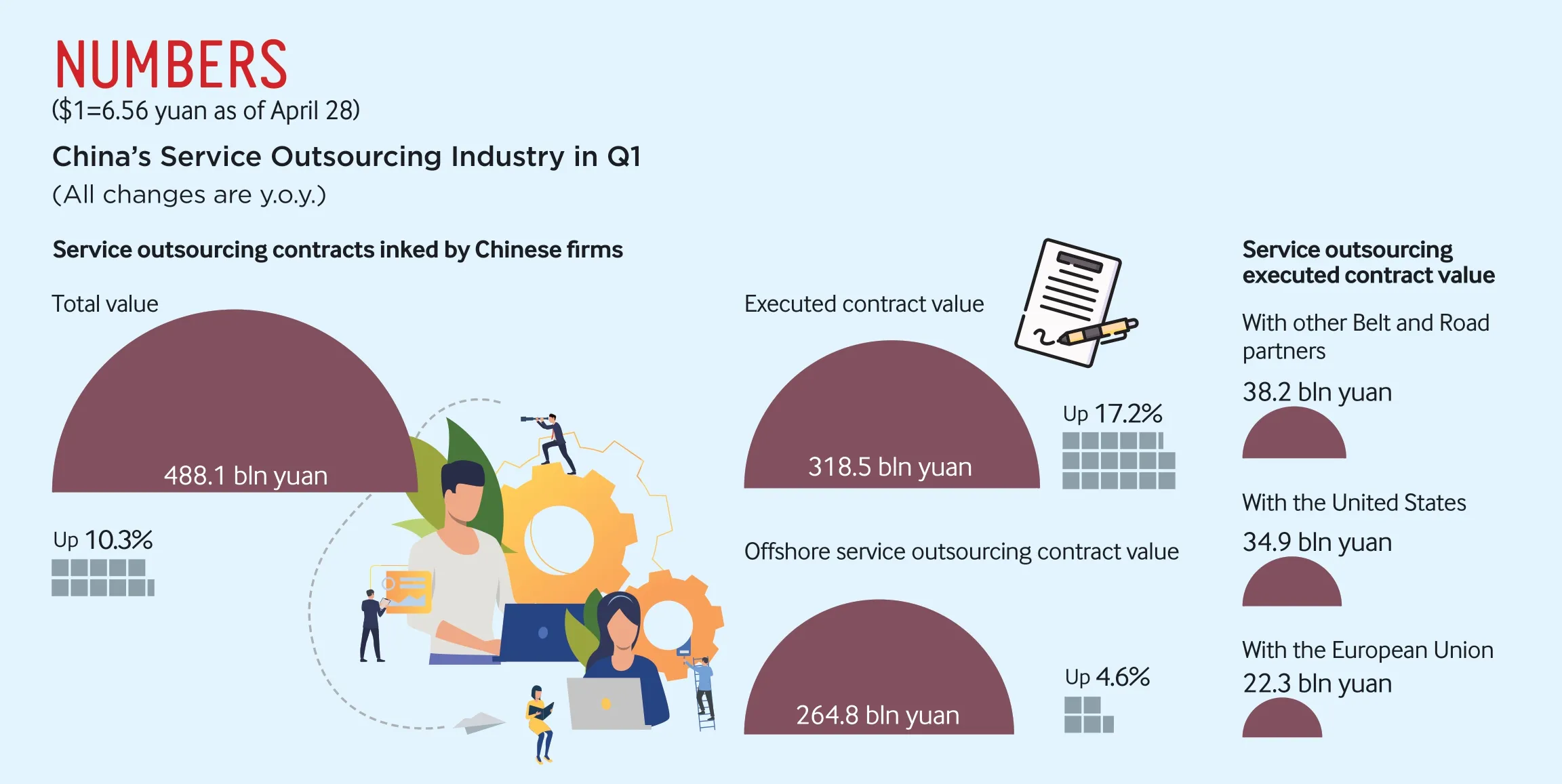
In 2021, the country authorized 696,000 invention patents,with average ownership of highvalue invention patents reaching 7.5 per 10,000 people, nearly twice that at the end of 2017,Shen said.
He added China had also witnessed significant improvement in the efficiency of the use of intellectual property rights (IPRs). The added value of patent-intensive industries reached 12.13 trillion yuan ($1.88 trillion) in 2020, up 5.8 percent year on year, accounting for 11.97 percent of the country’s GDP.
The added value of patentintensive industries should account for 13 percent of GDP by 2025, according to China’s 2021-35 plan for IPR development.
In 2021, Chinese companies filed 8,596 patent applications in other Belt and Road Initiative participating countries, a yearon-year increase of 29.4 percent;these countries in turn applied for 25,000 invention patents in China, Shen said.
Telecom Growth
The combined revenue of the telecommunications sector rose 9.3 percent year on year to 393.5 billion yuan ($60.9 billion) in the first quarter of 2022, a pace 2.8 percentage points faster than during the same period last year, according to the Ministry of Industry and Information Technology.
Emerging industries, such as big data, cloud computing,Internet data centers and the Internet of Things (IoT), registered rapid expansion. The emerging business revenue of the three telecom giants—China Telecom,China Mobile and China Unicom,surged 36.3 percent year on year to 79.7 billion yuan ($12.1 billion)during the period.
In breakdown, the revenue for cloud computing services soared 138.1 percent year on year,while that for big data and the IoT surged 59.1 percent and 23.9 percent, respectively.
By late March, China had 1.56 million 5G base stations, with 134,000 built in the first three months of the year.
Renewable Energy
In the January-March period,China’s wind power capacity jumped 17.4 percent year on year to 340 million kW, while solar farms saw capacity reach 320 million kW, an increase of 22.9 percent, according to the National Energy Administration.
By the end of March, the country’s total installed power generation capacity was approximately 2.4 billion kW, up 7.8 percent from a year ago, the data showed.
China has announced it will strive to peak carbon dioxide emissions before 2030 and achieve carbon neutrality before 2060.
The country is forging ahead in renewable energy development to improve its energy structure.
According to an action plan released last year, it aims to increase the share of non-fossil fuels in primary energy consumption to around 25 percent by 2030.
ODI on Rise
China’s non-financial outbound direct investment (ODI) reached 170.95 billion yuan ($26.1 billion)in the first three months of the year, up 6.3 percent year on year,official data showed on April 21.
In U.S. dollar terms, it rose 8.5 percent from a year ago, according to the Ministry of Commerce.
Other countries participating in the Belt and Road Initiative accounted for $5.26 billion of the sum, an increase of 19 percent year on year.
The ODI into wholesale and retail surged 36.3 percent from a year earlier to $5.45 billion, while investment in the manufacturing sector increased 13.3 percent, the ministry said.
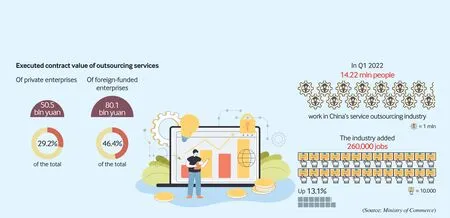

FRANCE People attend a rally following the presidential runoff in Paris on April 24.Incumbent President Emmanuel Macron was reelected with 58.54 percent of the votes
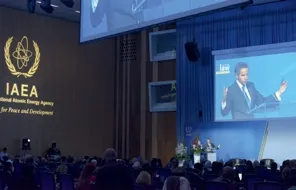
AUSTRIA The First International Conference on Nuclear Law: The Global Debate opens in Vienna on April 25. The five-day event was organized by the International Atomic Energy Agency,with participants from 127 countries

BELARUS A commemoration ceremony marking the 36th anniversary of the Chernobyl catastrophe, the world’s worst nuclear disaster to date, takes place in Minsk on April 26

BULGARIA Energy Minister AlexanderNikolov speaks at a press conference in Sofai on April 27. Russia has suspended its gas supply to Bulgaria, but the situation is under control, senior Bulgarian offciials said

MALTA A man holds up a Chinese calligraphy work reading“China-Malta Friendship” in Santa Lucija on April 24. The 50th anniversary of bilateral diplomatic relations was observed with the unveiling of a monument in the town’s Chinese Garden of Serenity

SPAIN People holding roses stroll through the streets of Barcelona on April 23, also known as St. George’s Day. The festival celebrates the patron saint of Catalonia through traditions based on love and culture
MATH GENIUS JOINS TSINGHUA
Prominent Chinese-American mathematician Yau Shing-Tung has announced his retirement from his position at Harvard University, to teach fulltime at Tsinghua University in Beijing, aiming to help China become a math powerhouse within the coming decade.
Born in 1949 in Shantou, Guangdong Province, Yau became the first Chinese-American winner of the Fields Medal, regarded as the Nobel Prize in mathematics, in 1982.He is considered one of the major contributors to the development of modern differential geometry and geometric analysis.
Yau has been dedicated to improving China’s mathematics education. Over the years, he has initiated many math competitions across China and established research centers at a number of renowned Chinese institutions, including Tsinghua, Zhejiang and Southeast universities.

Local authorities’ efforts to contain the resurgence of COVID-19 in Guangzhou,Guangdong Province, have necessitated lockdowns not only of residential communities, but also of some of the city’s hospitals. Many of these medical institutions are taking innovative measures in order to maximize their operational ability despite their locked-down status.
The measures include creating quarantine zones that facilitate the intake of patients,establishing health hotlines to provide phone consultations, and having medications delivered directly to outpatients’ doors.
Hospitals in many other cities have not taken this flexible and innovative approach,leading to worsening health outcomes for patients and wavering support for the dynamic zero-COVID-19 policy. For the policy to receive widespread support, effective measures need to be taken to ensure the needs of the people are met in the way they currently are in Guangzhou’s hospitals.
“The speculation that China will build a military base in the Solomon Islands is pure disinformation fabricated by a handful of people who harbor ulterior motives.”
Wang Wenbin, spokesperson for China’s Foreign Ministry,at a press briefing on April 25
“China and the U.S. should meet challenges together, maintain the stable development of agriculture, enhance the resilience of agricultural supply chains, ensure domestic food security, and promote cooperation for international food security.”
Qin Gang, Chinese Ambassador to the United States,at the 2022 China-U.S. High-Level Agricultural Dialogue in Iowa,the U.S., on April 21

The Central Government is aiming to create a record 10.76 million new jobs for college graduates this year. The target is part of efforts to combat the effects of COVID-19 on graduate employment.
In previous years, top students could expect to receive multiple job offers; however, with disruptions not only to recruitment processes but also entire businesses many fresh graduates are now being left indefinitely unemployed. The problem is particularly acute for graduates as many are employed by small companies, which have been disproportionately affected by the pandemic.
In Beijing alone, 27 of the nearly 100 colleges and universities have yet to restore faceto-face classes, and some students have yet to return to campus. The graduation of some science students’ has been disrupted because they are unable to conduct the scientific experiments they need to complete to graduate. Additionally, even students who have returned to campus may be unable to finish their internships due to lockdowns and restrictions imposed by their universities. All these make the students’ job hunting even harder.
According to the National Bureau of Statistics, the unemployment rate for those aged between 16 and 24 stood at 15.3 percent early this year, a rise of 2.2 percentage points year on year. Superficially, the rise results from a surge in college graduates; however,in addition to the impacts of COVID-19,structural issues are partially to blame, with the skills of the labor force currently unable to match the demands from business and industry. In the long run, to solve the employment issue among college graduates, the key will be to develop their ability to renew their knowledge and capabilities in accordance with the demands of the market.
The frequency with which smartphone manufacturers release new models has been increasing rapidly in recent years and, as it does so, so too has the volume of used phones that require responsible disposal.
While some components of these phones are a source of highly valuable metals, others can release pollutants such as heavy metals into the environment.
Despite many manufacturers offering exchanges or discounts for used phones,low prices and concerns over privacy mean just 4 percent of used smartphones are recycled in China.
Addressing these problems, and supporting the development of component recycling into an industry are expected to raise this rate, reducing environmental pollution and the current waste of resources, and leading to decarbonization and green development.
NEW TAOBAO AND TMALL TOP
Trudy Dai Shan, one of Alibaba’s founding members in 1999, has succeeded Daniel Zhang Yong as legal representative at both Taobao Software Co. and Zhejiang Tmall Technology Co., where she also serves as chairperson and general manager.
Appointed CEO of Alibaba Group in May 2015, Zhang will step back from his role as legal representative of the corporate entities behind Taobao Marketplace and Tmall,following the biggest ever management reshuffle initiated by China’s leading e-commerce company last December.
Dai, who has worked across multiple business segments in Alibaba, last December was chosen to head Alibaba’s China digital commerce unit, which combines the company’s consumer-facing and wholesale online marketplaces. In January, she introduced her first major initiative in that role by reorganizing the Taobao and Tmall backend operations.

“When it comes to a deadly virus,ignorance is not bliss. The World Health Organization (WHO) continues to call on all countries to maintain surveillance.”
Tedros Adhanom Ghebreyesus, WHO Director General,at a press briefing on April 26
“In the last few years there has been a trend toward deglobalization.But what the signing of the Regional Comprehensive Economic Partnership tells you is that there is an appetite for integration within Asia.”
Krishna Srinivasan, a deputy director in the International Monetary Fund’s Asia and Pacific department,in a recent interview with Xinhua News Agency

